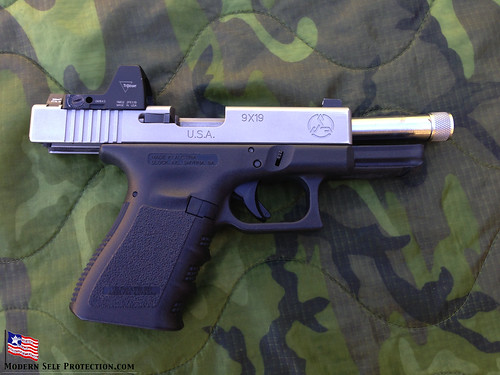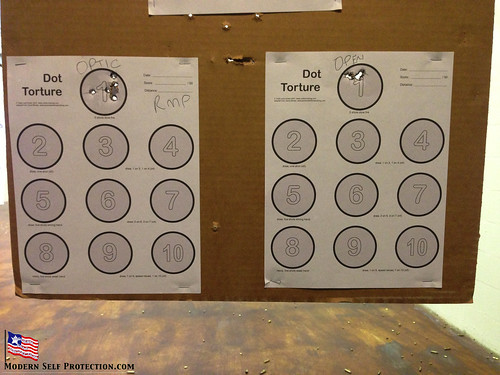
Lately, dot sights have been all the rage in the rifle community. It went from competition shooters, to Special Forces guys, to regular military and some where along the way, everyone adapted it. Handgun competition shooters have been using the same style dot sights for years on their handguns, now the tactical world is catching on.
I was sent a Glock 19 slide manufactured by One Source Tactical with an RMR dot sight milled into the slide in front of the suppressor style rear sight. The competition set-ups are mounted on a scope mount that attaches to the frame and hovers over the top of the slide letting the slide move beneath it. These new ones are milled into the slide and ride back and forth when the slide moves. This wasn’t possible a couple years ago because the sights couldn’t take the force created as the slide moved back and forth.
I always liked the thought of the competition guns, but never could get used to it because the sights sit so high above the gun it would require me to totally retrain myself on using one. And then, finding a holster that would actually hold the gun with that set up was almost impossible. Most competition holsters designed to hold the competition guns require a walking strap or lock so the gun doesn’t fall out while you walk around. They were designed for speed and nothing else.
One Source Tactical and others have been trying to solve all these problems, and mostly have. Now I wanted to know if it was something I wanted to spend money on. The set up is worth a little over $1,000 depending on what dot sight and what company makes or mills the slide. I only had the slide for a week (the owner wanted it back and I would too if it was mine!). I put about 300 rounds through it at three different ranges, one outdoor and two indoor (AC is nice sometimes).
Here are all my thoughts and tests:
The first day I got it, I started dry practice and looking for a holster. None of the holsters I have will fit it without taking some of the holster off, so I didn’t work from the holster. At first, dry practice was hard to retrain the brain. I was given the advice, find the normal sights on the gun and then you will see the dot, and it worked to start. I thought that was crazy because why would I want a dot if I have to find the normal sights first, but it worked as a crutch to start with. The dot sight sits a little higher than normal sights so you have to work a little different when you bring the gun up into your line of sight. Finding the normal sights and then the dot helped to start working with the gun.
After about 30 minutes I was no longer looking for the sights and just finding the dot. The first day I shot about 30-40 rounds shooting at steel while moving. I was teaching a class and had to demonstrate movement drills. I was a little worried that I would mess it up with the new system, but it worked fine. I couldn’t tell any difference in speed or accuracy from my normal sights.
So, a couple days later, I went to the indoor range to work on accuracy because I’ve heard that is what these sights excel at. I like the “Dot Torture” drill. I shot the drill twice on two different days.
The first day, I shot the drill by switching the slides. I shot the RMR the first string, then changed the slide and fired the same string with my stock slide with Warren Tactical sights on it. My first groups I shot to warm up looked like this:

I thought the test was over, but continued to fire because… well if you had the RMR, the range, and the ammo would you stop? So I continued to shoot. The groups got better really fast.
The groups got better to the point that I really couldn’t see a difference. So I came back a couple of days later with a shot timer to run the test again and do some speed drills. These are all my targets:
[AFG_gallery id=’13’]
My scores were so close it could have been user error. But where I did see an improvement was one handed shooting. The reason for that was that I could see mistakes in my trigger squeeze fast enough with the RMR to stop, release the trigger and start again. With open sights I couldn’t recognize my error until the shot broke. They were called fliers, but that doesn’t really help since the bullet had already gone down range. Once it’s out, you can never get it back.
After the Dot Torture, I did some speed work. I didn’t have a holster that would fit the Glock with an RMR, so I started with the gun by my side. When the timer beeped I shot two rounds onto a blank piece of computer paper at 10 yards. The spread with the RMR was noticeably better then the shots fired with the open sights, but the open sights where faster by a good amount. My splits (or time between shots) were also faster with the open sites. In full disclosure here, I have been shooting open sights my entire life and only working with dot sights in the last couple years, and only have a week working with a dot sight on a pistol. So with more training that could change, but I was looking for something that would make me a better shooter right away. That trick piece of gear everyone is looking for. I also wanted a noticeable difference to justify the price.
I also took the weapon on the road with me. I visited a close friend on vacation and we went to an old indoor range with poor lighting. My friend is a decent shot and he wanted to work on accuracy. So I spent some time with him and let him shoot the Glock with the RMR on it. He didn’t have any noticeable difference in group sizes between the Glock and his Springfield XD with factory sights on it. The Glock did attract the attention of the range safety officer, so I let him shoot it, too.
That session was really no help for me justifying the expense. In the end, the RMR is on my list of things I want, but it’s way down the list. I think the $1,000 would be better spent on getting a couple good courses and ammunition. The only reason it made it on my list was cool guy stuff, and that it let me see my trigger squeeze better, so it could be a good training tool.
Stay Safe,
Ben
[AFG_gallery id=’14’]
Hey – i just finished listening to your podcast about your experience with the Glock/RMR combo. In regards to the thread protector getting loose all the time, have you considered using a crush washer or peel washer like what is used to keep the flash hider on the AR15 from coming off? They come in 1/2 inch and 5/8 sizes. Just a thought.
Actually someone from TSD said they have an O ring they make that can fix the problem.
But that is a great idea, I should have thought of using something like that, since I probably have a couple of them sitting around here. Lock tite is the only thing I could think of at the time.